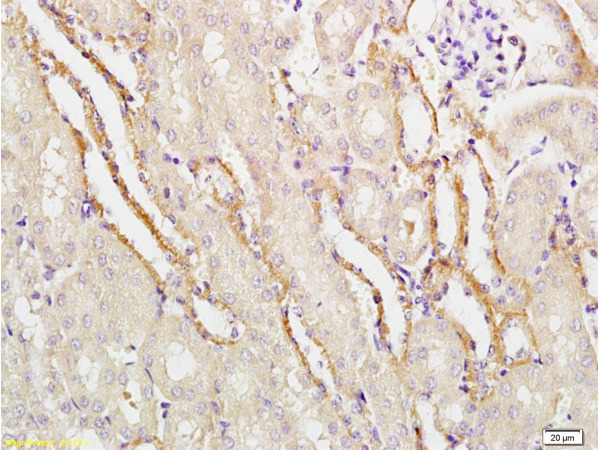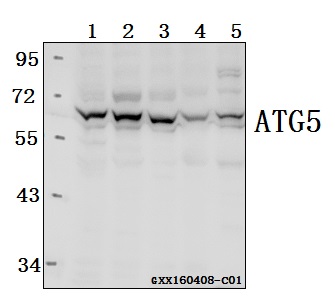
Immunohistochemical analysis of paraffin-embedded human ovarian cancer, using ATG5 Antibody.
Anti-ATG5/Apg5 Rabbit Monoclonal Antibody
M00240
ApplicationsImmunoFluorescence, ImmunoPrecipitation, Western Blot, ImmunoCytoChemistry, ImmunoHistoChemistry
Product group Antibodies
ReactivityHuman, Mouse, Rat
TargetATG5
Overview
- SupplierBoster Bio
- Product NameAnti-ATG5/Apg5 Rabbit Monoclonal Antibody
- Delivery Days Customer9
- ApplicationsImmunoFluorescence, ImmunoPrecipitation, Western Blot, ImmunoCytoChemistry, ImmunoHistoChemistry
- CertificationResearch Use Only
- ClonalityMonoclonal
- Clone IDGCD-1
- Gene ID9474
- Target nameATG5
- Target descriptionautophagy related 5
- Target synonymsAPG5, APG5-LIKE, APG5L, ASP, SCAR25, hAPG5, autophagy protein 5, APG5 autophagy 5-like, ATG5 autophagy related 5 homolog, apoptosis-specific protein
- HostRabbit
- IsotypeIgG
- Protein IDQ9H1Y0
- Protein NameAutophagy protein 5
- Scientific DescriptionBoster Bio Anti-ATG5/Apg5 Rabbit Monoclonal Antibody catalog # M00240. Tested in WB, IHC, ICC/IF, IP applications. This antibody reacts with Human, Mouse, Rat.
- ReactivityHuman, Mouse, Rat
- Storage Instruction-20°C
- UNSPSC12352203
References
- Li T, Xiao P, Qiu D, et al. NCX1/Ca(2+) promotes autophagy and decreases bortezomib activity in multiple myeloma through non-canonical NFκB signaling pathway. Cell Commun Signal. 2024,22(1):258. doi: 10.1186/s12964-024-01628-4Read this paper
- Feng Z, Zhang S, Han Q, et al. Liensinine sensitizes colorectal cancer cells to oxaliplatin by targeting HIF-1α to inhibit autophagy. Phytomedicine. 2024,129:155647. doi: 10.1016/j.phymed.2024.155647Read this paper
- Chen B, Wu J, Yan Z, et al. 1,3-Substituted β-Carboline Derivatives as Potent Chemotherapy for the Treatment of Cystic Echinococcosis. J Med Chem. 2023,66(24):16680-16693. doi: 10.1021/acs.jmedchem.3c01326Read this paper
- He M, Li L, Li J, et al. rs2253820 Variant Controls Blood Pressure Dip After Stroke by Increasing CLOCK-BMAL1 Expression. Transl Stroke Res. 2023,14(4):472-489. doi: 10.1007/s12975-022-01063-yRead this paper
- Wang T, Xiao G, Lu Q, et al. Synergistic Lysosomal Impairment and ER Stress Activation for Boosted Autophagy Dysfunction Based on Te Double-Headed Nano-Bullets. Small. 2022,18(27):e2201585. doi: 10.1002/smll.202201585Read this paper
- Zhao N, Li Y, Wang C, et al. DJ-1 activates the Atg5-Atg12-Atg16L1 complex via Sirt1 to influence microglial polarization and alleviate cerebral ischemia/reperfusion-induced inflammatory injury. Neurochem Int. 2022,157:105341. doi: 10.1016/j.neuint.2022.105341Read this paper
- Yi J, Wang X, Song K, et al. Integrated metabolomics and mechanism to reveal the protective effect of kaempferol on pulmonary arterial hypertension. J Pharm Biomed Anal. 2022,212:114662. doi: 10.1016/j.jpba.2022.114662Read this paper
- Chen Y, Cao B, Zheng W, et al. eIF3k inhibits NF-κB signaling by targeting MyD88 for ATG5-mediated autophagic degradation in teleost fish. J Biol Chem. 2022,298(3):101730. doi: 10.1016/j.jbc.2022.101730Read this paper
- Craven RJ, Frazier HN, Thibault O. Dependence of glucose transport on autophagy and GAPDH activity. Brain Res. 2022,1776:147747. doi: 10.1016/j.brainres.2021.147747Read this paper
- Man S, Wang H, Zhou J, et al. Cardiac Glycoside Compound Isolated from Helleborus thibetanus Franch Displays Potent Toxicity against HeLa Cervical Carcinoma Cells through ROS-Independent Autophagy. Chem Res Toxicol. 2019,32(12):2479-2487. doi: 10.1021/acs.chemrestox.9b00318Read this paper








